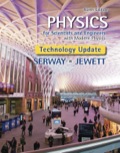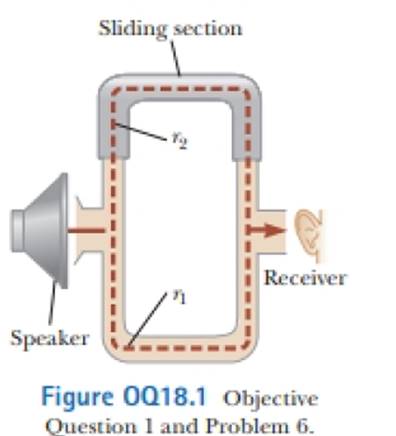
Concept explainers
In figure OQ18.1 (page 566), a sound wave of wave-lenght 0.8 m divides into two equal parts that recombine to interfere constructively, with the original difference between their path lengths being |r2 – r1| = 0.8 m. Rank the following situations according to the intensity of sound at the receiver from the highest to the lowest. Assume the tube walls absorb no sound energy. Give equal ranks to situations in which the intensity is equal.

(a) From its original position, the sliding section is moved out by 0.1 m. (b) Next it slides out an additional 0.1 m. (c) It slides out still another 0.1 m. (d) It slides out 0.1 m more.
The ranking of the situations according to the intensity of sound at the receiver in descending order.
Answer to Problem 18.1OQ
The ranking of the situations according to the intensity of sound at the receiver in descending order is
Explanation of Solution
Given info: The wavelength of the sound wave is
Write the expression for the intensity heard by the receiver.
Here,
For Case (a);
The section is moved out by
The path length
Thus, the value of
Write the expression for phase difference,
Substitute
Thus, the value of
Substitute
Thus the value of
For Case (b);
The section is again moved out by
The path length
Thus, the value of
Write the expression for phase difference,
Substitute
Thus, the value of
Substitute
Thus the value of
For Case (c);
The section is again moved out by
The path length
Thus, the value of
Write the expression for phase difference,
Substitute
Thus, the value of
Substitute
Thus, the value of
For Case (d);
The section is again moved out by
The path length
Thus, the value of
Write the expression for phase difference,
Substitute
Thus, the value of
Substitute
Thus, the value of
The ranking of the intensity of each case is,
Conclusion:
Therefore, the ranking of the situations according to the intensity of sound at the receiver in descending order is
Want to see more full solutions like this?
Chapter 18 Solutions
EBK PHYSICS FOR SCIENTISTS AND ENGINEER
- Solve and answer the question correctly please. Thank you!!arrow_forwardA spiral transition curve is used on railroads to connect a straight portion of the track with a curved portion. (Figure 1) Part A v = v₁ft/s 600 ft y = (106) x³ If the spiral is defined by the equation y = (106)³, where x and y are in feet, determine the magnitude of the acceleration of a train engine moving with a constant speed of v₁ = 30 ft/s when it is at point x = 600 ft. Express your answer to three significant figures and include the appropriate units. ? a = Value Unitsarrow_forwardsolve and answer the problem correctly please. Thank you!!arrow_forward
- Solve and answer the question correctly please. Thank you!!arrow_forwardSolve and answer the question correctly please. Thank you!!arrow_forwardWhen the motorcyclist is at A, he increases his speed along the vertical circular path at the rate of = (0.3t) ft/s², where t is in seconds. Take p = 360 ft. (Figure 1) Part A 60° Ρ B If he starts from rest at A, determine the magnitude of his velocity when he reaches B. Express your answer to three significant figures and include the appropriate units. v = Value Submit Request Answer ་ Part B ? Units If he starts from rest at A, determine the magnitude of his acceleration when he reaches B. Express your answer to three significant figures and include the appropriate units. 11 ? a = Value Unitsarrow_forward
- The car starts from rest at s = 0 and increases its speed at a₁ = 7 m/s². (Figure 1) Part A = 40 m Determine the time when the magnitude of acceleration becomes 20 m/s². Express your answer to three significant figures and include the appropriate units. ? t = Value Units Part B At what position s does this occur? Express your answer to three significant figures and include the appropriate units. s = Value Submit Request Answer ? Unitsarrow_forwardSolve and answer the question correctly please. Thank you!!arrow_forwardSolve and answer the question correctly please. Thank you!!arrow_forward
- Solve and answer the question correctly please. Thank you!!arrow_forwardSolve and answer the question correctly please. Thank you!!arrow_forwardr 2. Measuring Length mm 1 cm 2 3 INCH 1 16THS 5 6 7 8 9 10 11 FAIRGATE COLD SPRING, NEW YORK 2 3 12 1. Using the metric (top) scale only, what units are being used for the long lines with the numbers? Hint: Remember that 2.54 cm = 1 in. 2. What are the units of the small lines? 3. How many decimal places should be recorded using this tool? 4. What is the length of the red line? Note: Make sure to use the correct units and decimal places. 5. Now observe your ruler. What metric units are used on your ruler? 6. How many decimal places should you record when using your ruler? 7. Measure a box, book, coin and can and fill out the data table below. Make sure to use units and the correct number of decimal places for your ruler. Table 1: Measuring Length Data Table Object Length of the box Length Local PR Distribution Only $99/Release. Get Started On Our Website Now! V 2 217arrow_forward
 Principles of Physics: A Calculus-Based TextPhysicsISBN:9781133104261Author:Raymond A. Serway, John W. JewettPublisher:Cengage Learning
Principles of Physics: A Calculus-Based TextPhysicsISBN:9781133104261Author:Raymond A. Serway, John W. JewettPublisher:Cengage Learning Physics for Scientists and Engineers, Technology ...PhysicsISBN:9781305116399Author:Raymond A. Serway, John W. JewettPublisher:Cengage Learning
Physics for Scientists and Engineers, Technology ...PhysicsISBN:9781305116399Author:Raymond A. Serway, John W. JewettPublisher:Cengage Learning Physics for Scientists and Engineers: Foundations...PhysicsISBN:9781133939146Author:Katz, Debora M.Publisher:Cengage Learning
Physics for Scientists and Engineers: Foundations...PhysicsISBN:9781133939146Author:Katz, Debora M.Publisher:Cengage Learning University Physics Volume 1PhysicsISBN:9781938168277Author:William Moebs, Samuel J. Ling, Jeff SannyPublisher:OpenStax - Rice University
University Physics Volume 1PhysicsISBN:9781938168277Author:William Moebs, Samuel J. Ling, Jeff SannyPublisher:OpenStax - Rice University College PhysicsPhysicsISBN:9781938168000Author:Paul Peter Urone, Roger HinrichsPublisher:OpenStax College
College PhysicsPhysicsISBN:9781938168000Author:Paul Peter Urone, Roger HinrichsPublisher:OpenStax College Physics for Scientists and EngineersPhysicsISBN:9781337553278Author:Raymond A. Serway, John W. JewettPublisher:Cengage Learning
Physics for Scientists and EngineersPhysicsISBN:9781337553278Author:Raymond A. Serway, John W. JewettPublisher:Cengage Learning





